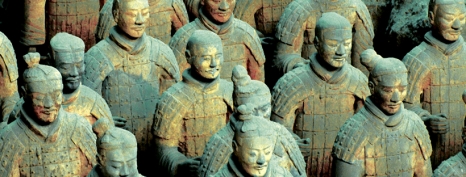The “Eighth Wonder of the World” refers to the Terracotta Army, consisting of thousands of soldiers guarding the tomb of the first emperor of China, Qin Shi Huang. Since February 4, 2018, the Regional Museum in Stalowa Wola has been showcasing a remarkable exhibition of life-size replicas of these world-famous figures. The discovery of the Terracotta Army, made by farmers digging a well in 1974, is considered one of the most significant archaeological events of the 20th century. This incredible find, which turned out to be a magnificent necropolis for Emperor Qin, was designated a UNESCO World Heritage Site in 1987.
The exhibition features dozens of terracotta warriors, including the emperor himself. The figures include infantry soldiers, archers, and officers. Original figures can only be seen at the Museum of the Terracotta Army of the First Emperor Qin in Xi’an, China. However, the replicas were crafted using the same techniques as the originals. Since the discovery of the tomb, more than 8,000 statues have been unearthed. The terracotta—made from clay with the appropriate texture and cohesion—was transported to the mausoleum site from across China over two thousand years ago. The figures were handcrafted by hundreds of artisans and fired in large kilns located near the tomb.
Both scientists and visitors are fascinated by the individuality of the terracotta soldiers. The statues are crafted with great care, showcasing varied physiognomies and expressions, and they are depicted in a variety of poses, equipped with diverse weaponry and hairstyles. Notably, they were outfitted with real weapons, including swords, halberds, and crossbows, with functional forged elements still intact today.
This extraordinary funerary procession serves as a fantastic source of information about the clothing, armaments, and military hierarchy that existed during the time of the First Emperor of united China, the great emperor of the Qin dynasty, Shi Huang. Ascending to the throne at the age of 13, he waged victorious wars against all ancient Chinese kingdoms, unifying ancient China and thus laying the foundation for the modern Chinese state. He implemented a uniform system of measures and weights, a common currency, and an alphabet. He also initiated the construction of the Great Wall of China. While he was a wise emperor, he was also known for his cruelty. Scholars estimate that around 700,000 people worked on the construction of the imperial tomb and the army that guarded it. It is likely that all the workers, sculptors, architects, and artisans involved in creating this mausoleum were buried within it, taking with them one of history’s greatest mysteries to the grave.
The exhibition offers an excellent opportunity to learn about one of the oldest civilizations, its achievements, and, most importantly, the history of China’s first ruler and the fascinating story behind the creation of the Terracotta Army.
Educational Offer
The exhibition is complemented by an interesting and diverse educational program tailored for all audience groups:
- For preschools: Educational Offer for Preschools
- For primary school grades 1-3: Educational Offer for Grades 1-3
- For primary school grades 4-6: Educational Offer for Grades 4-6
- For middle schools: Educational Offer for Middle Schools
- For high schools: Educational Offer for High Schools
